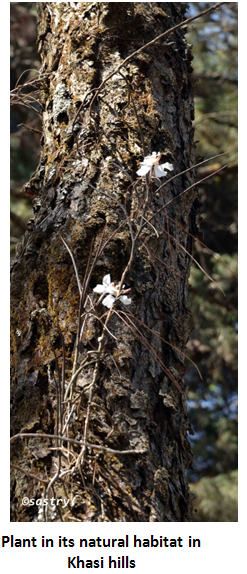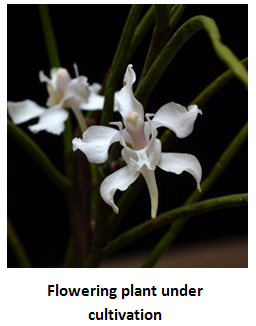Species of the Month – March 2014
Papilionanthe vandarum (Rchb.f.) Garay
synonyms: Aerides cylindricum Hooker; Aerides vandarum Rchb. f.; Vanda vandarum (Rchb.f.) K.Karas.
It is a terete vanda and commonly known as The Vanda like papilionanthe. These love to be in full sun but they also like to have high humidity. There are few terete vandas which produce big flowers and also attractive. The terete leaves may not be very attractive. There are many terete Vandas but now they are grouped under genus Papilionanthe, however, the common name Vanda is still  widely used. In this group the most spectacular and beautiful flowered one is Papilionanthe Miss Joaquim ‘Agnes’ which is also the national flower of Singapore. This was a natural hybrid between P. hookeriana x P. teres. Among the species, Papilionanthe teres, P.hookeriana, and P.subulata are some of the popular ones.
widely used. In this group the most spectacular and beautiful flowered one is Papilionanthe Miss Joaquim ‘Agnes’ which is also the national flower of Singapore. This was a natural hybrid between P. hookeriana x P. teres. Among the species, Papilionanthe teres, P.hookeriana, and P.subulata are some of the popular ones.
Distribution: Found in Assam, Sikkim, NE Himalayas, Nepal, Bhutan, Myanmar and Southern China.
Plant: Most of the terete vandas would like to climb. The leaves are modified into a pencil like structure (named after this) of 50 – 60mm. These leaves grow alternately on the main stem. Plants produce racemes of flowers from each node. They are erect growing epiphytes forming large masses with plenty of branching. Generally the flowering season is in spring with a 1 to 3 flowers on 30 cm long inflorescence which arises from the stem between the leaf bases. Flowers are produced in pairs of white and pink in colour
Light: The terete Vandas including P. vandarum like to grow in full sun with plenty of humidity and aeration.
Temperature: These plants withstand temperature up to 32-34 degree Celsius.
Humidity: This is a typical epiphyte which tends to do well with lots of humidity. Plants tend to dry if the humidity goes down. Plants need to be watered copiously during dry spells.
Nutrition: These plants require very little maintenance. With some care, they produce plenty of flowers. Dilute fertilising with a balanced fertiliser such as 19-19-19 with micro nutrients will result in good response with beautiful flowers. Several organic manures such as fish emulsion, sea weed extract and diluted cow dung manure.
Propagation: Like other monopodials, this plant can be propagated by top cuttings and one has to ensure that the top cutting should be about one foot with plenty of aerial roots. Does well with staking.
Pests & Diseases: Although the plant does not suffer from any major diseases, scale insects are a problem when atmosphere is dry. These can be controlled by use of insecticides.
Article by : Dr K.S. Shashidhar
Good article with beautiful photographs.
Hello,
I am a french botanist who is searching for a picture of Aerides cylindricum. I would like to use it freely in a possible article for a french botanical journal, non commercial. I am interested by your picture of Papilionanthe vandarum. So, I ask you the permission to use it, without any fee. The botanical association is “Société Botanique du Centre-Ouest”, well known in France and more widely.
Best regards
Henri Mathé
Hi
Please go ahead and use it in tour article, only I request you to give photo credit to me – sastry
Thank you
Shashidhar sastry
Beautiful orchid. Common in Meghalaya hills and forests.